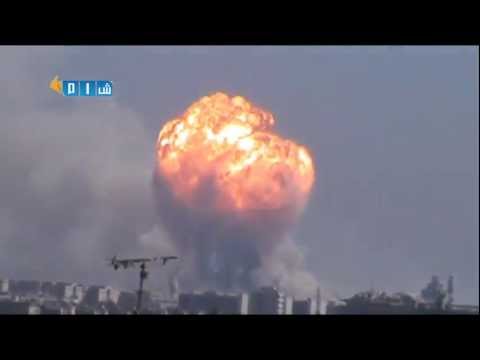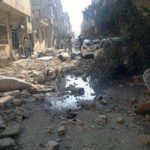LATEST: SNC Accuse Assad Of Targeting Flour Mill In Eastern Ghouta, Damascus Countryside
Hours after the regime claimed victory in Homs, with the capture of the Khalidiya neighborhood after seven weeks of attacks — and even as President Assad was in a photo-opportunity with troops for Army Day — insurgents hit back dramatically on Thursday.
Opposition fighters struck a regime arms depot in the Wadi al-Dahab section with two high-precision rockets. Video documented a large fireball after an initial explosion, but could not establish the extent of damage or the number of casualties.
AP cite an unnamed “resident of Homs” who says he spoke to the Syrian Red Crescent, who told him that 22 civilians were killed in the attack, while the British-based Syrian Observatory for Human Rights, recycling rumors, said 40 people were killed and at least 160 people were wounded.
One resident in the area said the sound of multiple explosions could be heard for more an hour as munitions exploded after the strikes.
An EA correspondent, drawing on sources inside Syria, indicated that the attack might be a symbolic “last roll of the dice” for the local opposition, as insurgents try to hold out in their remaining positions in Homs. He said Homsis “literally gave their last bucks” for the two rockets.
Yet while that effort succeeded in seizing headlines as well as striking a key target, the regime was also exacting its toll on the opposition on Thursday. Heavy shelling of insurgent-held al-Waer area of Homs — see separate feature — culminated in a strike which killed several people, according to local activists.
SNC Accuse Assad Of Targeting Flour Mill In Eastern Ghouta, Damascus Countryside
The Syrian National Coalition on Friday accused forces loyal to Syrian President Bashar al-Assad of deliberately targeting Hutaytat Al Turkman’s mills in eastern Ghouta in the Damascus countryside, as part of a tactic of “systematic reprisals against Syrian civilians”.
The SNC said in a statement that the Free Syrian Army had taken control of the mills in order to distribute flour and bread to civilians in besieged eastern Ghouta. The SNC accused Assad’s forces of launching six surface-to-surface rockets at the mills, in an attack which it said left 28 dead and around 80 more wounded.
Activists reported on July 31 that regime forces had launched a fierce attack on Hutaytat al-Turkman in Eastern Ghouta.
Video: Claimed Footage Of Car Bomb Attack On Aleppo Central Prison
Claimed footage of a large explosion at the Aleppo Central Prison on Friday morning:
There are reports in several Arabic-language media outlets that the assault on the prison included car bombing carried out as a joint operation between a number of insurgent groups including Jabhat al-Nusra and Harakat Ahrar As-Sham.
Activists said that the attack was a major assault involving medium and heavy machine guns, which targeted the second and third floors and the outer wall of the prison, and that six detainees and 3 guards were killed with others wounded. The reports remain unverified.
UN Human Rights Head: Investigate Insurgent Treatment of Regime Forces in Khan al-Assal
United Nations human rights chief Navi Pillay said on Friday that she wants an independent investigation into insurgent treatment of regime fighters after the opposition’s capture last week of Khan al-Assal, near Aleppo.
“Based on the analysis by my team to date, we believe armed opposition groups in one incident — documented by a video — executed at least 30 individuals, the majority of whom appeared to be soldiers,” Pillay said.
Footage posted by the insurgent Ansar al-Khalifa Brigade showed opposition troops near piles of corpses. The video also recorded insurgents abusing captured fighters under interrogation.
See Syria Videos: Insurgents Kill & Abuse Captured Regime Fighters in Khan al-Assal
“Opposition forces should not think they are immune from prosecution. They must adhere to their responsibilities under international law,” Pillay said.
Photo: Wadi Al-Zahab After Thursday’s Attack
Activists have circulated this photograph, purportedly of a street in the pro-regime Wadi Al-Zahab district in Homs following Thursday’s insurgent attack. It is not possible to verify the authenticity of the image:
Continued Shelling, Machine Gun Fire On Al-Wa’er, Homs
Activists reported continued regime shelling in the Al Wa’er neighborhood in Homs overnight and on Friday, after extremely heavy attacks on Thursday.
This footage, taken last night, shows explosions in the neighborhood as shells fall:
A Facebook page run by activists from Al Wa’er reported on Friday that residents of the neighborhood had been unable to sleep, out of fear of the continued shelling.
The activists said that pro-Assad militias were targeting the neighborhood with heavy weapons and light machine guns, including Dushka guns, rockets, mortar shells and B-10 recoilless rifles.
Civilians had been killed and others wounded shelling in the shelling, which had continued into Friday morning, activists said, as Assad’s militias were “targeting everything that moves”.
So far on Friday, there had been several mortar shells and rockets fired that destroyed homes and public property.
Jordanian Border Police Arrest Arms Smugglers From Syria
Jordanian border police on Thursday night arrested a group of people trying to smuggle a large cache of arms, mainly machine guns, across the border from Syria, an army spokesman said Friday.
LBCI report that the group arrested late Thursday included Jordanians and other Arab nationalities.
Regime Allows Journalists Into Qusayr To Report On Reconstruction
The Assad regime has invited Western journalists into Al Qusayr, a strategic town on the Lebanese border that its forces recaptured from insurgents on June 5, to report on the town’s reconstruction.
The regime used State media to push its line on reconstruction — a crucial element of the Assad regime’s strategy for winning over local hearts and minds and for gaining control on the ground — in Qusayr immediately after it retook the town.
In June, the Syrian government said it was offering local people cash gifts of 100,000 SYP (about $800) each to return and recontstruct their homes. Damascus has also pledged to renew the town’s electricity, water and medical facilities — possibly with Iranian assistance.
On Friday, the regime offered AFP access to officials in Qusayr, who said that small numbers of people are beginning to return to the town.
What is interesting about the report is that the regime officials AFP quote offer different estimates of how many people have returned to Qusayr. The the town’s new local telecoms chief, Mtanios al-Shaer, said that at most 2,000 people have returned to the city. In contrast, the head of the local municipality, Shaza Murad, suggests a more accurate figure would be around 600.
Another interesting quote comes from the man in charge of security in Qusayr, Lieutenant Colonel Raed Abboud, who does not quite echo the regime line on reconstruction. Instead, he says: “We are doing what we can at the moment to get things up and running again…But in terms of reconstruction, that’ll have to wait. This is a country at war.”
The language that the regime officials use — and which AFP reports — matches that of State media. The officials repeat the regime line that the “terrorists” — the regime’s term for the insurgency — and not regime forces, were responsible for the extensive damage in Qusayr.
AFP cites Shaer as saying that “The terrorists destroyed everything 24 hours before the town was liberated, and caused damage of a billion Syrian pounds [$57 million]…We’ve just installed a 1,200-line hub for residents and officials, and 80 lines are now working. But before, of course, capacity was much greater.”
AFP quote civilians who returned to the town — unsurprisingly, those its reporters interviewed held pro-government sympathies, echoing official parlance by referring to the rebels as “terrorists.”
Beyond the regime propaganda, the report does offer some telling information about the effect the fighting has had and continues to have on ordinary Syrians from Qusayr.
Retired official Mahmud Ahmad, 74, and his wife Futun, only left Qusayr for two days. “We have no money to rent a house anywhere else, so we came back even though there’s no water or electricity,” Futun explained.
While the predominantly Muslim populated Western districts of the town are now virtually deserted, in the Christian east people are starting to restore the area. The Mar Elias church, which was partially destroyed and vandalised, has been cleaned up and holds weekly services again.
More Footage Of Attacks In Al Wa’er, Homs
More footage of Thursday’s extensive shelling in the Al Wa’er suburb of Homs. Activists say several people were killed when the regime fired rockets at the neighborhood.
Activist @samersniper tweeted this image of a man said to have been killed in the attack:
الشهيد علاء المحمود استشهد في مجزرة #الوعر البارحة #حمص RIP Martyr Alaa Mahmoud, killed in #Waar massacre y/day #Homs pic.twitter.com/4PjK175XNM
— samer (@samersniper) August 2, 2013
Casualties
The Local Coordination Committees claim 113 people were killed on Thursday, including 31 in Homs Province, 27 in Damascus and its suburbs, and 26 in Idlib Province.
The Violations Documentation Center puts the number of dead at 68,210 since the start of the conflict, a rise of 104 since Thursday. Of these, 51,787 are civilians, an increase of 87 from yesterday.


